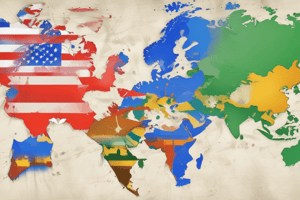Podcast
Questions and Answers
What percentage of Russia's population earned their living from agriculture at the beginning of the twentieth century?
What percentage of Russia's population earned their living from agriculture at the beginning of the twentieth century?
- 31%
- 85% (correct)
- 50%
- 40%
Which cities were prominent industrial areas in Russia?
Which cities were prominent industrial areas in Russia?
- St Petersburg (correct)
- Berlin
- Paris
- Moscow (correct)
What was the main reason for the increase in factory establishments in the 1890s?
What was the main reason for the increase in factory establishments in the 1890s?
The extension of Russia's railway network and increased foreign investment in industry.
Workers in craft units enjoyed better working conditions than those in factories.
Workers in craft units enjoyed better working conditions than those in factories.
What percentage of the factory labor force was made up of women by 1914?
What percentage of the factory labor force was made up of women by 1914?
What was the Russian peasant custom regarding land usage?
What was the Russian peasant custom regarding land usage?
Political parties were legal in Russia before 1914.
Political parties were legal in Russia before 1914.
The Russian Social Democratic Workers Party was founded in _____ by socialists who respected Marx's ideas.
The Russian Social Democratic Workers Party was founded in _____ by socialists who respected Marx's ideas.
What was the main disagreement between Social Democrats and Socialist Revolutionaries?
What was the main disagreement between Social Democrats and Socialist Revolutionaries?
What did Lenin believe about the peasant class?
What did Lenin believe about the peasant class?
Flashcards are hidden until you start studying
Study Notes
Economic Structure of Russia at the Start of the 20th Century
- Approximately 85% of Russia's population relied on agriculture, significantly higher than the 40-50% in France and Germany.
- Russia was a key grain exporter, producing mainly for market and subsistence needs.
- Industrial activity was concentrated in St Petersburg and Moscow, with many factories emerging in the 1890s due to railway expansion and foreign investment.
- Coal production doubled and iron and steel output quadrupled by the early 1900s.
Workforce and Employment Conditions
- Factory and craft workshop worker numbers became nearly equal in some regions by the early 1900s.
- Most industrial facilities were owned by private industrialists, with government oversight ensuring minimum wage and working hours.
- Violations of labor regulations were common; craft workers sometimes endured 15-hour days compared to 10-12 hours in factories.
- Accommodation for workers varied, impacting their living conditions.
Social Divisions Among Workers
- Workers were stratified by skill level, with metalworkers in St Petersburg considering themselves elite.
- Women constituted 31% of the factory workforce by 1914 but earned significantly less, receiving between half and three-quarters of men’s wages.
- Worker divisions were reflected in attire and social interactions, though some associations existed for mutual aid during unemployment.
Strikes and Labor Unrest
- Strikes were a frequent occurrence in industries such as textiles (1896-1897) and metalwork (1902) in response to unfavorable working conditions or dismissals.
Land Ownership and Peasant Discontent
- The majority of land was cultivated by peasants, but ownership was concentrated in the hands of the nobility, the crown, and the Orthodox Church.
- Unlike in France, Russian peasants lacked respect for the nobility, viewing them as elite with power derived from service to the Tsar.
- Peasants expressed discontent through refusal to pay rent and violent uprisings against landlords, notably in 1902 and 1905.
Unique Characteristics of Russian Peasants
- Russian peasants practiced periodic pooling of land through communes (mir), redistributing it based on family needs, setting them apart from European agricultural practices.
Political Landscape and Socialism in Russia
- Political parties were illegal until 1914. The Russian Social Democratic Workers Party, formed in 1898, operated underground and mobilized strikes and worker activism.
- There was debate within socialism regarding the role of peasants; some believed their communal land practices necessitated a socialist revolution led by peasants rather than workers.
- Socialist Revolutionary Party emerged in 1900, advocating for peasant land rights.
Lenin and the Division in Socialist Ideology
- Lenin argued that organizational discipline was crucial for the Bolshevik group in the repressive Tsarist regime, focusing on controlling member quality and numbers.
- The Menshevik faction believed in a more open party structure, contrasting with Lenin's ideology.
Studying That Suits You
Use AI to generate personalized quizzes and flashcards to suit your learning preferences.




